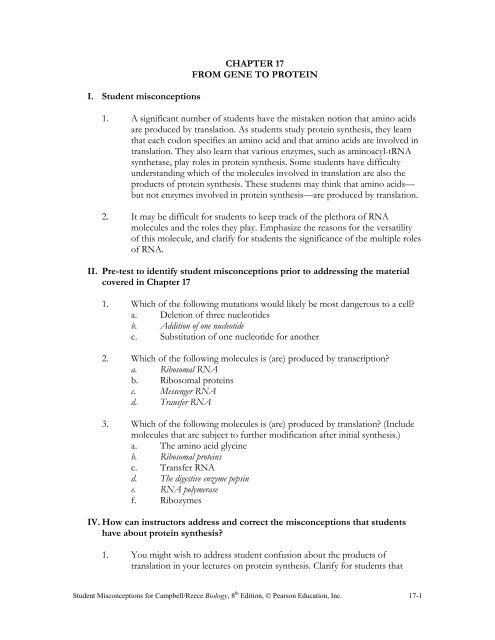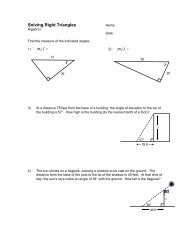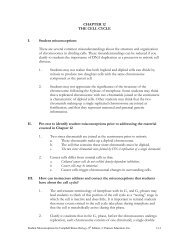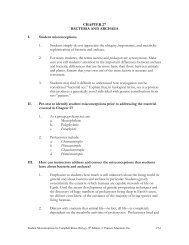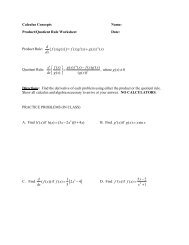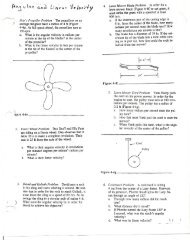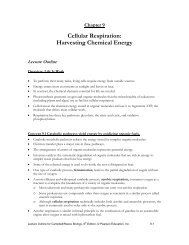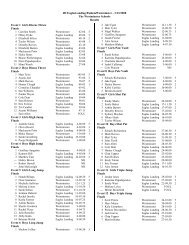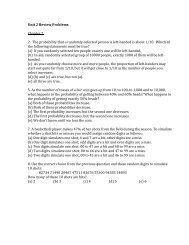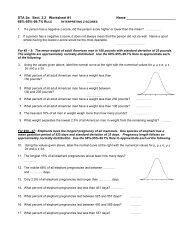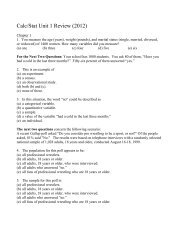CHAPTER 17 FROM GENE TO PROTEIN I. Student misconceptions ...
CHAPTER 17 FROM GENE TO PROTEIN I. Student misconceptions ...
CHAPTER 17 FROM GENE TO PROTEIN I. Student misconceptions ...
You also want an ePaper? Increase the reach of your titles
YUMPU automatically turns print PDFs into web optimized ePapers that Google loves.
I. <strong>Student</strong> <strong>misconceptions</strong><br />
<strong>CHAPTER</strong> <strong>17</strong><br />
<strong>FROM</strong> <strong>GENE</strong> <strong>TO</strong> <strong>PROTEIN</strong><br />
1. A significant number of students have the mistaken notion that amino acids<br />
are produced by translation. As students study protein synthesis, they learn<br />
that each codon specifies an amino acid and that amino acids are involved in<br />
translation. They also learn that various enzymes, such as aminoacyl-tRNA<br />
synthetase, play roles in protein synthesis. Some students have difficulty<br />
understanding which of the molecules involved in translation are also the<br />
products of protein synthesis. These students may think that amino acids—<br />
but not enzymes involved in protein synthesis—are produced by translation.<br />
2. It may be difficult for students to keep track of the plethora of RNA<br />
molecules and the roles they play. Emphasize the reasons for the versatility<br />
of this molecule, and clarify for students the significance of the multiple roles<br />
of RNA.<br />
II. Pre-test to identify student <strong>misconceptions</strong> prior to addressing the material<br />
covered in Chapter <strong>17</strong><br />
1. Which of the following mutations would likely be most dangerous to a cell<br />
a. Deletion of three nucleotides<br />
b. Addition of one nucleotide<br />
c. Substitution of one nucleotide for another<br />
2. Which of the following molecules is (are) produced by transcription<br />
a. Ribosomal RNA<br />
b. Ribosomal proteins<br />
c. Messenger RNA<br />
d. Transfer RNA<br />
3. Which of the following molecules is (are) produced by translation (Include<br />
molecules that are subject to further modification after initial synthesis.)<br />
a. The amino acid glycine<br />
b. Ribosomal proteins<br />
c. Transfer RNA<br />
d. The digestive enzyme pepsin<br />
e. RNA polymerase<br />
f. Ribozymes<br />
IV. How can instructors address and correct the <strong>misconceptions</strong> that students<br />
have about protein synthesis<br />
1. You might wish to address student confusion about the products of<br />
translation in your lectures on protein synthesis. Clarify for students that<br />
<strong>Student</strong> Misconceptions for Campbell/Reece Biology, 8 th Edition, © Pearson Education, Inc. <strong>17</strong>-1
enzymes catalyze steps in protein synthesis, but that they are also the<br />
products of protein synthesis. Recognize that students may not understand<br />
the source of amino acids that are used in translation, and address this topic<br />
directly.<br />
2. Discuss the relatively recent discovery of ribozymes, pointing out to students<br />
that our understanding of the processes of life continues to change and grow,<br />
and that each new discovery can lead to new and exciting questions.<br />
3. Emphasize to students that proteins are not the only catalysts in living cells.<br />
The discovery of ribozymes and the increasing recognition of the important<br />
role they play in translation have changed our understanding of protein<br />
synthesis and provided new insights into the origin of life on Earth. When<br />
you discuss ribozymes with your class, make the point that our understanding<br />
of the processes of life continues to change and grow, and that each new<br />
discovery can lead to new and exciting questions.<br />
IV. Post-test to identify whether students have corrected their <strong>misconceptions</strong><br />
Explain the significance of each of these characteristic features of transcription and<br />
translation:<br />
1. A promoter region is found several dozen nucleotide pairs upstream from<br />
the starting point for transcription.<br />
2. A 5 cap and a poly-A tail are added to a eukaryotic pre-mRNA molecule.<br />
3. The average length of a transcription unit along a eukaryotic DNA molecule<br />
is about 8,000 nucleotides, whereas an averaged-sized protein is about 400<br />
amino acids long.<br />
4. A number of genes are subject to alternative RNA splicing.<br />
5. Translation of mRNA involves the formation of polyribosomes.<br />
V. Reference<br />
Fisher, K. M. (1985). A misconception in biology: Amino acids and translation.<br />
Journal of Research in Science Teaching, 22(1), 53–62.<br />
<strong>Student</strong> Misconceptions for Campbell/Reece Biology, 8 th Edition, © Pearson Education, Inc. <strong>17</strong>-2


